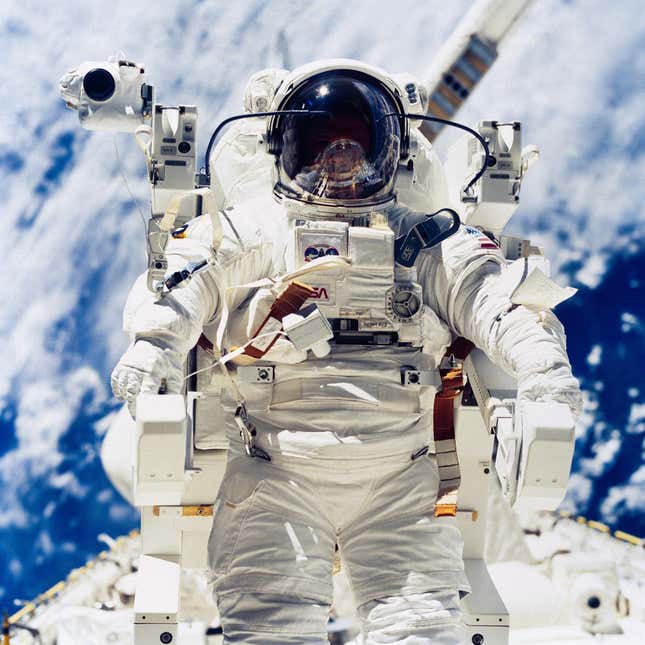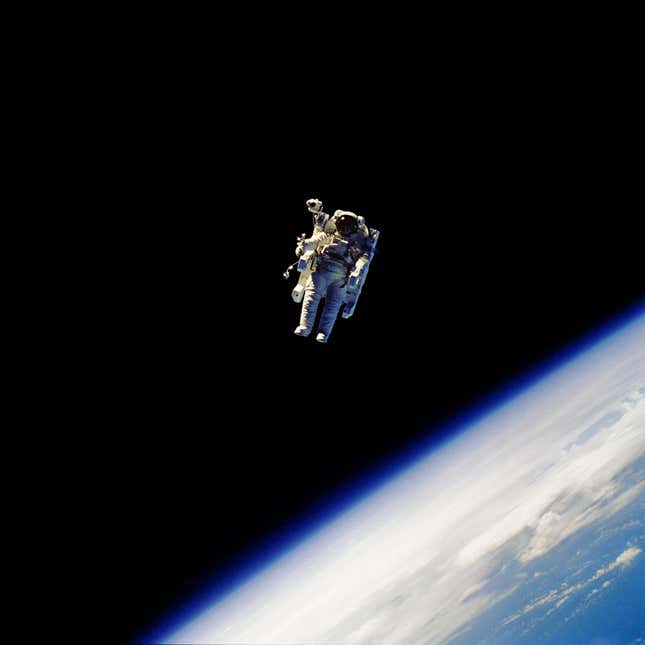Pulse-Pounding Photos Recall NASA’s Historic First Untethered Spacewalk, 40 Years On

It was forty years ago this week that two NASA astronauts embarked into uncharted orbital waters, becoming the first to perform a spacewalk without the benefit of a tether. These thrilling photos remind us of this extraordinary moment in spaceflight history.
Over the decades, hundreds of astronauts have bravely ventured outside their spacecraft to work in the dangerous void that is space. For the vast majority of these spacewalks, there was a common thread, so to speak—a safety tether linking the astronaut to their orbital home. In 1984, NASA experimented with an innovative approach to spacewalks, giving astronauts the freedom to zip around the Space Shuttle, and to do so while unattached. The tests were successful, but it never took off as an idea. Nonetheless, this experiment left us with some wild photos.

On February 3, 1984, the Space Shuttle Challenger embarked on its fourth mission making it just the tenth launch in NASA’s Space Shuttle program.

The STS-41B crew consisted of commander Vance Brand, pilot Robert Gibson (sitting up front), and mission specialists Robert Stewart, Ronald McNair, and Bruce McCandless II (back row). Both Stewart and McCandless were shown wearing NASA’s Extravehicular Mobility Units (EMUs), or spacesuits as normal people call them.

The Manned Maneuvering Unit (MMU) debuted on February 7, 1984. Previous spacewalkers had relied on tethers to remain connected to the Shuttle, but the MMU offered the capability for crews to venture beyond the cargo bay and conduct tasks away from the spacecraft. Robert Gibson captured this iconic image of McCandless from Challenger’s crew cabin, and it remains one of NASA’s most requested images. Indeed, this iconic image of the NASA astronaut “free-flying” in space is now one of the most recognizable and celebrated photographs in space exploration history.

“It may have been one small step for Neil,” McCandless quipped in reference to Armstrong’s famous words, “but it’s a heck of a big leap for me.” As The New York Times reported at the time, “Free of any lifeline and propelled into the dark void by tiny jets, they became, in effect, the first human satellites.”
The MMUs were powered by two dozen gaseous nitrogen thrusters stored in tanks on the astronaut’s backpack, enabling free movement in space. Control was achieved through hand controllers, allowing spacewalkers to adjust thrust and direction for precise navigation during extravehicular activities. The technology demonstration worked, but “many in the agency were fearful about the use of a self-propelled and untethered backpack in space,” as NASA historian Jennifer Ross-Nazzal wrote in her retrospective.

During the first untethered spacewalk, McCandless ventured a maximum distance of 322 feet (98 meters) away from the Space Shuttle. Hard to believe from this image, but the astronaut, like the Shuttle, was traveling around the Earth at speeds reaching 17,500 miles per hour (28,100 kilometers per hour). McCandless would’ve been toast had he smashed into a micrometeorite or space junk, but such is the risk of any spacewalk, tethered or not.

Returning the favor, McCandless captured this stunning view of Challenger, showing the Shuttle from his perspective. Sadly, the Challenger was destroyed during a launch in January 1986, killing all seven crew members aboard.

McCandless and Stewart performed two concurrent spacewalks during the mission, one on February 7 and the second on February 9, for a total duration of 12 hours and 12 minutes. The duo used these extravehicular activities to practice the procedures intended for capturing and repairing a malfunctioning satellite for an upcoming mission. The image above shows McCandless during the first EVA. Two units were tested during the mission, noted by serial numbers 2 and 3.

In the photo above, McCandless appears to be walking along Challenger’s payload bay, but he was actually being maneuvered above the cargo bay using the Manipulator Foot Restraint (MFR) and Remote Manipulator System (RMS), together known as the “cherry picker.” The RMS is more commonly known as the Canadarm, which debuted in 1981. This combination allowed for precise and controlled movement in space, which is crucial for tasks such as repairing satellites or constructing and maintaining space stations.

Among the many stunning photos taken during the STS-41B mission is this shot of McCandless standing on the cherry picker. Similar procedures are now commonly performed using robotic arms on the International Space Station, precluding the need for MMUs, which, to be fair, were a bit dodgy in terms of risk and utility.

Robert Stewart also tested out the MMU during the mission. The photo above shows the NASA astronaut gliding several feet above the Shuttle’s cargo bay.

The MMUs were used twice more in 1984, during the April STS 41-C mission and the November STS 51-A mission. After that, they were never used again, with NASA citing safety reasons. Moreover, NASA found other, safer ways, for astronauts to perform work outside the Shuttle.
Related article: The Coolest—and Most Frightening—Spacewalks in History
That said, NASA did perform an untethered spacewalk in September 1994 to test a backpack known as Simplified Aid for EVA Rescue (SAFER), which is strictly meant for emergencies should astronauts become untethered during EVAs.

Challenger returned back home on February 11, following a successful mission that lasted for nearly eight days. Interestingly, it marked the first landing of a Shuttle at its launch site, in this case Kennedy Space Center in Florida.
Related slideshow: 16 Iconic NASA Photos That Changed Everything

